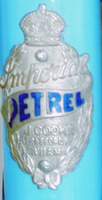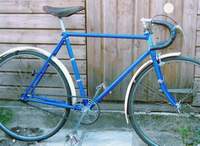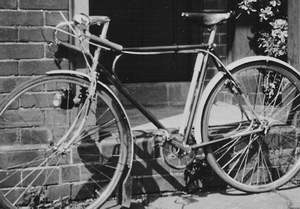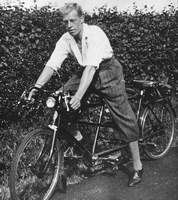Cooke, Joe
Posted: Tuesday 02nd June 2020

Joseph Cooke was born in Aston, Birmingham, on 20 March, 1876 and died in Solihull on 25 August 1958. As a boy Joe lived in a house in Severn Street off the Horsefair and attended St Jude’s School in Hurst Street and finished school at the age of eleven.
On leaving school Joe was employed as a foreman frame builder in a local cycle factory, believed to be the Rover Cycle Co. Ltd. since there were many similarities between the build of the Imperial Petrel and some of the Rover cycle. Whilst working there he met Alice Sheath, whom he married at St Thomas-in-the-Moors in 1897. The marriage produced six children, five girls and a boy (Raymond).Joe had a friend at the factory who unfortunately led him into heavy drinking. To break this cycle his wife Alice persuaded him to leave the factory and set up his own cycle shop at 49 Alfred Street, Sparkbrook, on 1 April 1903. In the beginning Joe repaired bikes in a back-room workshop while his wife sold sweets from the shop in the front-room. As the business built up they were able to move into larger premises at 335 Stratford Road, Sparkbrook.
Joe choose to call his frames ‘Imperial Petrel’ because he thought that the bird symbolised speed and grace. He designed the head badge with ‘Petrel’ picked out in a dark blue and it was used on a lighter blue head tube on his otherwise black frames (see image above right). As a schoolboy I always admired the sporty frames with the striking head tube and badge, at one stage red enamel was tried for badge but blue won the day.As the business continued to expand the adjacent premises at 337 were acquired and the two shops were knocked into one with a workshop to the rear containing a brick brazing hearth.

Cooke only sold his own frames but carried a large stock of accessories with which to build them up into complete machines and of course to sell to his cycling customers. They also supplied made-to-measure cycling suits which were in the vogue at this time. Complete machines were exported around the world, including Russia, and he supplied parts and fittings to Ted Crane who later founded Hercules cycles in a factory in Birmingham. Hercules developed into a large mass-producer of cycles and Ted Crane was knighted to become Sir Ted Crane. Hercules made an attempt to buy out Joe Cooke cycles in 1946 but the offer was spurned. The shop was open six days a week, Monday to Saturday, from 8am to 8pm with an early closing day on Wednesday as was the custom at this time. Joe’s daughter Edith worked in the shop along with another assistant Harry, who also carried our repairs.
Joe Cooke was the sole frame builder and produced about four to five frames each week. Some were built to the normal triangular format whereas he also produced a model known as the ‘Superigid’ which had almost semi-circular stiffening tubes between the head and down tubes and also between the seat and chain stays. This became known amongst cyclists as the ‘Jug Handle’, which was not a name recognised by Joe himself. The frame was usually built with the ‘handles’ front and rear as on the illustration to the right. However, it is known that at least one was built with the tubes at the head only, one with the tubes on the stays at the rear, and one with a single tube at the rear on the drive side. He also designed a three-speed derailleur gear which worked well but he decided not to proceed with the complicated process of patent application that would be needed before manufacture could commence.
Disaster struck during WWII when Joe’s only son Raymond, who was a Flying Officer in the RAF, was killed on active service. Not unnaturally this affected the family a great deal but they persuaded Joe to take on his daughter Henrietta’s son David to work in the business and this helped in some way to enable it to return to an even keel. The grandson took on the tasks of wheel-building, lug-filing and the cleaning up of bare frames preparatory to them going the Rossiters, a local finishing firm for spraying, lining, etc.
In the early 50s Joe decided to retire from the cycle trade and the business was sold to Alf Curnock for £2000. Tommy Godwin, an Olympic medalist had been interested in purchasing the business but was pipped at the post.
A sample of frame numbers related to estimated year of manufacture:
5031 – 1930
6031 – 1933
6269 – 1935
6843 – 1938


Customers’ memories of Joe Cooke and Imperial Petrel Cycles
Walter Smith, a keen member of the Midlands CTC owned two Imperial Petrels and built up a friendship with Joe Cooke. His first was purchased in 1935, a CTC De Luxe Superigid. He paid £12 9s 6d for it including a discount of 5/6d. the frame was finished in black with the traditional blue head tube and was fitted with blue anodised bars. He used steel HP rims for touring and also had a pair of ‘cane’ sprints for racing. In 1937 Walter was Chairman of the local CTC section and their fixture card had an advert on the rear stating: ‘Come to Cooke’ and ‘Ride an Imperial Petrel and see the difference’.
Walter’s friend Miss Aileen Bone (later to become Aileen Smith) also purchased a Superigid in 1938. It had a 21″ frame finished in green lustre with chrome fork and rear ends. It was fitted with chrome 26″ rims on BSA hubs secured by wingnuts, Williams C34 chainset, quill pedals, alloy bars, cantilever brakes, Brooks saddle, white celluloid mudguards and pump, Lucas Challis bell, mileometer and lamps. Walter eventually sold his machine but Aileen kept hers until 1991 when it was acquired by the Marque Enthusiast who restored it to its original glory. (see image on left)
Charles Woodcock purchased his first Joe Cooke cycle in 1928 and noticed that several details were similar to Rover Cycles of the era. The frame angles were 68° parallel and the wheels on this machine were 26 x 1 3/8″ Endricks with John Bull Speed tyres. A few years later he got Joe to build him a lighter frame with super resilient forks. On taking delivery of it he found that the forks had too much give for his liking so he had them changed for a more rigid pair.
Around this time the fashion was for very small frames with some makers such as Selbach using taper tubes and others, like Baines, twin-tube. Charles remembers that Arthur Morris of the Speedwell B C got Joe to build him a frame with twin down tubes starting either side of the head and converging at the bottom bracket shell. The design was registered but no others have come to light.Joe then came up with the Superigid frame which he had tested against a conventional Cooke frame at Birmingham University and decided to put it into production. This design appealed to many riders and sales took off. In 1935 Charles had one built with rapid taper short seatstays and he found it very good to ride, especially on hills. In 1943, Charles’ wife-to-be also purchased a CTC De Luxe frame (frame no.: 7498) finished in a metallic Blue shaded copper and chrome finish. It was fitted with front and rear calliper brakes, Brooks saddle, 26″ steel HP wheels, Williams C43 chainset and steel dropped bars. The writer also obtained this machine in 1991 and is restoring it to its original condition.
In common with many in the cycle trade Joe Cooke had a reputation for being difficult to get on with and was very particular about who he dealt with but Charles broke down this barrier and got on well with him. In the 1930s Charles twice needed tubes replaced in his frames due to accidents and he was unemployed at this time. Joe repaired the frames for the cost of the materials only and told Charles to pay him when he found work.
Dorothy Holt was 14 years of age in 1909 and for her birthday received a brand new Imperial Petrel cycle. She was already an experienced cyclist, being the youngest member of the Northern Section of the C T C. Dorothy had four brothers, all keen cyclists and all owners of Imperial Petrels. It was they who decided on the build of this machine which had Endrick rims, ‘open sided’ tyres, North Road bars, Lucas King of the Road lamps and a Challis bell. The frame was finished in black, as was the fashion in those days. A few months later she completed a ladies 100 in 8 and still has the certificate. Her brothers were all racing cyclists and she was with them when the Warwick Road Club was formed.
Arnold Mason had his first cycle in 1926 when he was 16 years old and the following year he toured Scotland on it using a single-speed fixed wheel. His cycle was stolen in 1933 and he replaced it with a Joe Cooke Superigid finished in leaf green, the colour of the Warwickshire Road School. He thinks it was the first of the Supergrids built and he had helped Joe Cooke with the calculations for the initial design. He raced this machine a lot and was very successful on it. He also bought a used Cooke tandem in the same year which he rode with his prospective wife. To complete the line-up, Mrs Mason (one of the first lady members of the Warwickshire Road Club) bought a Joe Cooke in 1934 built with a short top tube and finished in fawn.
Vernon Smith, a keen cyclist, ordered a tandem from Joe Cooke in 1930. It was a double-gents, finished in black with the trademark blue head tube with metal badge. It had hub brakes and was built with black spokes on black rims with chrome centres. Liking black, he ordered black celloloid mudguards and handlebars which were mounted on a chrome stem. Drive was through a three-speed Cyclo gear. Mrs Smith also had a ‘rational’ cycling suit made to measure at Cooke’s and Joe was said to have sat her on a chair so as to measure her without actually touching! The suit fitted her perfectly. Vernon himself was quite a stylish gentleman as the picture on the right shows. Mr and Mrs Smith used the tandem extensively for touring holidays and weekend rides, including a Birmngham to Bristol and back in a day jaunt.
Posted: Tuesday 02nd June 2020
This article appears in the following categories.
Upcoming Events
Whether you are looking for a gentle social meet up, or a 100-mile ride browse the community’s upcoming events and plan your next weekend outing.
